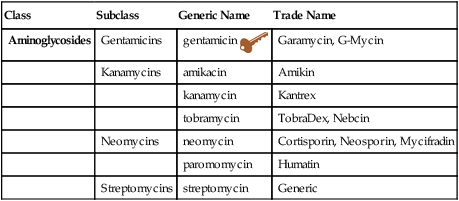Chapter 64 Aminoglycosides generally are reserved for the treatment of patients with serious gram-negative infections that are resistant to other antibiotics. They normally are not used in primary care, but they are important antibiotics, and all providers should be familiar with their use. They are more potent than other antibiotics and are used systemically for serious infections. Aminoglycosides have a narrow therapeutic window, so careful dosing based on the pharmacokinetics of the drug is required. These agents are associated with significant nephrotoxicity (10% to 20%), ototoxicity (3% to 14%), and neuromuscular blockade (extremely rare). Aminoglycosides interact with β-lactam antibiotics, destroying the β-lactam ring, an amino group that renders both antibiotics inactive. They are excreted renally, so patients with impaired renal function are at increased risk for toxicity. Their use in treatment of infection is either IV or IM. Oral aminoglycosides are not absorbed; their only use is for suppression of intestinal bacteria in GI preoperative surgical preparation. Table 64-1 provides a summary of indications for each product. Aminoglycosides are used extensively in topical preparations. Topical aminoglycosides are discussed in Chapters 13 and 14 for localized treatment of the eye, skin, ear, and so forth. Nine aminoglycosides are available in the United States. Aminoglycosides were derived from a soil actinomycetes bacterium that had been systematically screened for antimicrobials. Gentamicin is a mixture of three closely related constituents. TABLE 64-1 Indications for Aminoglycoside Agents
Aminoglycosides
Class
Subclass
Generic Name
Trade Name
Aminoglycosides
Gentamicins
gentamicin ![]()
Garamycin, G-Mycin
Kanamycins
amikacin
Amikin
kanamycin
Kantrex
tobramycin
TobraDex, Nebcin
Neomycins
neomycin
Cortisporin, Neosporin, Mycifradin
paromomycin
Humatin
Streptomycins
streptomycin
Generic

Indications
amikacin
gentamicin
kanamycin
neomycin
streptomycin
tobramycin
Systemic infections∗
+
+
Gram-negative bacteremia/sepsis
+
+
Peritonitis
+
+
+
Meningitis
+
+
+
Pneumonia
+
+
+
Urosepsis
+
+
+
+
Tuberculosis
+
+
Endocarditis
+
+
+
MRSA/penicillinase-resistant strains
Infectious diarrhea
+
+
GI sterilization
+
+
Pyoderma
+
+
Superficial infections
+
+
Staphylococcus,
Streptococcus,
Pseudomonas
![]()
Stay updated, free articles. Join our Telegram channel

Full access? Get Clinical Tree


